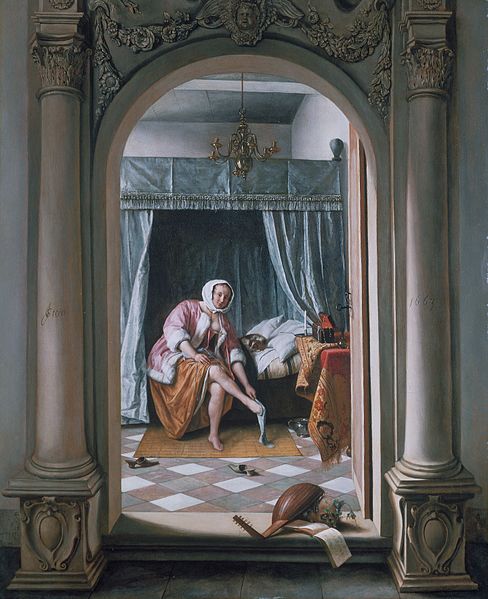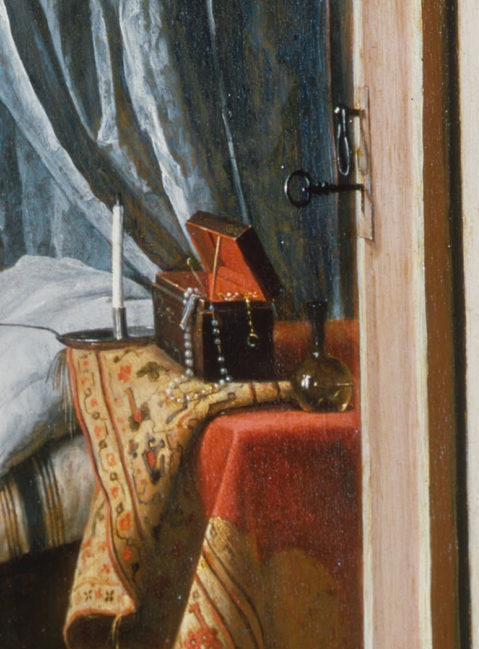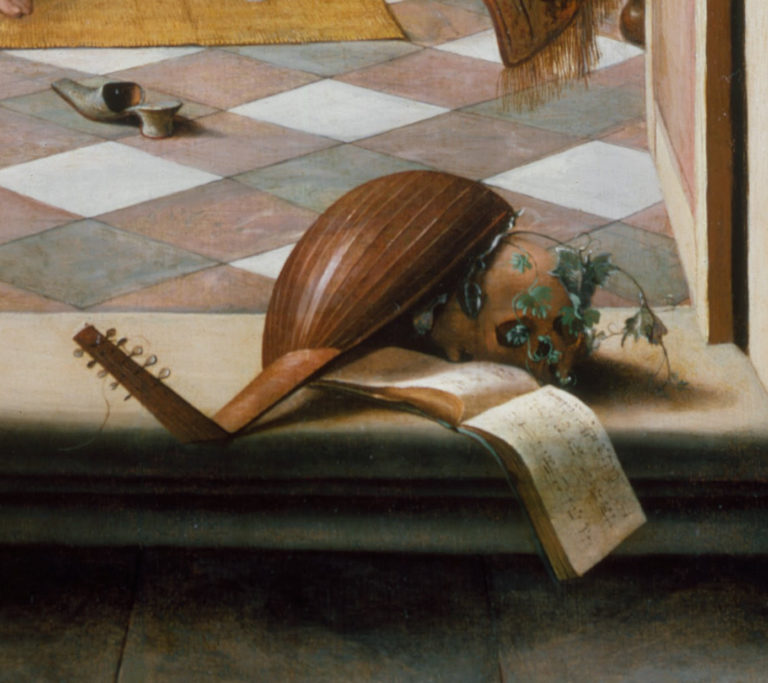I expect we have all looked at old paintings in country houses or galleries, and admired the skills of the artist. How they managed to create lifelike portraits and scenes of life in the days before photography with nothing more than paint, a brush and some canvas is incredible.
I used to view them simply as decorative pictures. But I now realise that, in some cases, I was completely missing the point, and that hidden messages placed within the painting by the artist were going straight over my head. Some of these messages can be moralistic, religious, or forewarning, and some can be simple jokes or puns, but they can all still be seen if you know what to look out for.
Take one example: A Woman at Her Toilet painted in 1663 by Dutch artist Jan Steen (seen below).

In this instance the word ‘toilet’ means the process of washing oneself, dressing, and attending to one’s appearance. At first sight this looks like a rather dull picture of a woman sitting on a bed in a grand but messy bedroom – a snapshot of a moment in a woman’s life 400 years ago. But why would Steen paint such a scene? Well, we need to ‘read’ the painting to reveal the clues to the message that Steen was sending us – a message which can still mean much to us today.
If we start with the woman herself, she leans forward to pull on a stocking which may have only been removed a few moments ago, since a garter mark can still be seen on her calf. Her fur-edged bed jacket gapes open revealing her undergarments. Her bed is unmade, alluding to prior activity, and she stares alluringly out at the viewer, her eyes looking directly out of the picture at you, and therefore you are involved in this scene. The picture (or the artist) is talking to you personally. The implication here is that she is a woman of loose morals, perhaps a prostitute, preparing herself for her next customer.
The woman pulls on her stocking, regaining her respectability and modesty, but too hurried a manoeuvre could ladder the garment rendering it useless – symbolising a ruinous end to impetuous and hasty actions.
Her shoes are scattered across the floor, perhaps thrown off in earlier passion, showing a lack of concern for propriety and orderliness. On the bed is a dog, a Spaniel, normally one of the liveliest breeds, but now it is still and resting between bouts of excitement.
Under the bed is a chamber pot, pictured next to her stocking. The Dutch name for a stocking is ‘kous’ which was slang for fornication, and the Dutch for chamber pot (piespot) combined with kous as ‘pieskous’ was slang for a prostitute. The message here would have been clear for any 17th-century Dutchman.
A modest chandelier hangs from the ceiling, and should be throwing light on the scene (enabling the truth to be clearly seen), but it is empty of candles. Perhaps the bedroom is not used at night-time. Instead it reflects incidentally the natural light from the outside world through unseen windows.

On the table is a small glass wine jug, symbolising good times and enjoyment, but also representing drunkenness and downfall.
A jewellery box, embodying valuable possessions, reputation and life, lies open and vulnerable on the table. A pearl necklace and other jewellery can be seen spilling out from the box, perhaps the reward of a mis-spent life, openly on display and vulnerable to theft, the image overflowing with temptation.
An erect candle, once literally burning with light, now stands a spent force, cold and extinguished.

Thrown face-down onto the floor is a lute, no longer capable of bringing beautiful uplifting music to life since a string and some of the tuning pegs are broken, yet its fingerboard remains provocatively upright.
Under the lute lies a skull, indicating death, with a frond of poison ivy, reminiscent of graveyards, trailing through the eye orbits, suggesting that the eyes can lead to destruction. These elements are left on the steps of the room as a warning to anyone contemplating crossing the threshold.
The room itself is a lady’s boudoir, a private space into which we are spying. The whole scene is framed by the arched doorway, signifying probity – strong classical pillars, and an entrance beyond which danger lies. You, the viewer are outside the scene, where you will remain if you know what’s best for you.
Steen’s surname, which means ‘stone’ in Dutch, can be seen written on the stone pillar on the left; it is a visual pun, suggesting that his name is written in stone forever.
The square shapes seen in the tiles of the floor, the rug, the bed panels and the ceiling point to a strong and solid framework (or society), contrasting with the carefree scattering of her personal possessions signifying a personal choice in her actions.
The curtains around the bed, intended to provide privacy, are pulled loosely aside, implying a blithe availability.
And finally a key, normally a symbol of safety and security, can be seen in the keyhole of the door to her room, but the key is rendered useless since the door is swung wide open. The key is also in the outside of the door, so the option to use it is with the viewer, not the woman who has left it available for use. You, as the viewer, must use the key to unlock the true meaning of the picture.
Jan Steen loved to paint realistic scenes from everyday life in the Netherlands, and often put himself in the picture (literally) by adding his face to a character in the scene as a miniature self-portrait. Indeed, some have suggested that the woman in the picture discussed here is Steen’s wife Margriet, posing as a prostitute attempting to corrupt her husband the artist – another joke on the viewer.
As far as I am aware The National Archives does not hold any original artwork by any Dutch Masters, but we do hold some photographic copies of artworks among the records of the Copyright Office of the Stationers Company in series COPY 1, relating to the registration of copyright in published works from 1842-1924. These include several paintings by Jan Steen including those named The Hurdy Gurdy, The Broken Eggs, The Sick Lady, Grace Before Meal, and The Alchemist, all photographs taken for a Dr Albert Bredius, Prinsegracht 6, The Hague, Holland, for commercial purposes, perhaps a brochure for an exhibition to be held at the time.
So next time you come across an antique painting, remember that it is not just a pretty snapshot with an ‘accidental’ background. Nothing in the painting is there by chance. Everything in the artwork has been placed there for a purpose, whether it is to impress the viewer, to enhance the subject, or to convey a meaning – which might well be a message to you from centuries past.

Thank you for such an insightful commentary. The lute’s erotic connotations perhaps echo the lines in “Richard II”: “He capers nimbly in a lady’s chamber/ To the lascivious pleasing of a lute.”
Very possibly ! Thanks for your comment David.
Very interesting and enlightening. Shall never look at an old master the same ever again. Thank you.
Its a fascinating subject isn’t it? Thanks for your comment.
That was very interesting. Thank you.
You’re welcome, thanks for your comment.
Love the story in the picture reminds of the saying a picture is a thousand words.
Absolutely ! Thanks you for your comment.
Thank you for opening my eyes to such detail.
I am glad you liked it Dianna.
I too found this very interesting. I have not studied art and had not realised that this type of painting was a reflection on life at the time. I have always wondered why Dutch women almost invariably are pictured with their heads covered?
A question of a fashion historian Jane ! Thanks for your comment.
Fascinating insight!
Thanks for your comment Jasmine. I’m glad you enjoyed it.
will make me look more closely an eye opener
Thanks for this description
You’re welcome. Thanks for your comment.